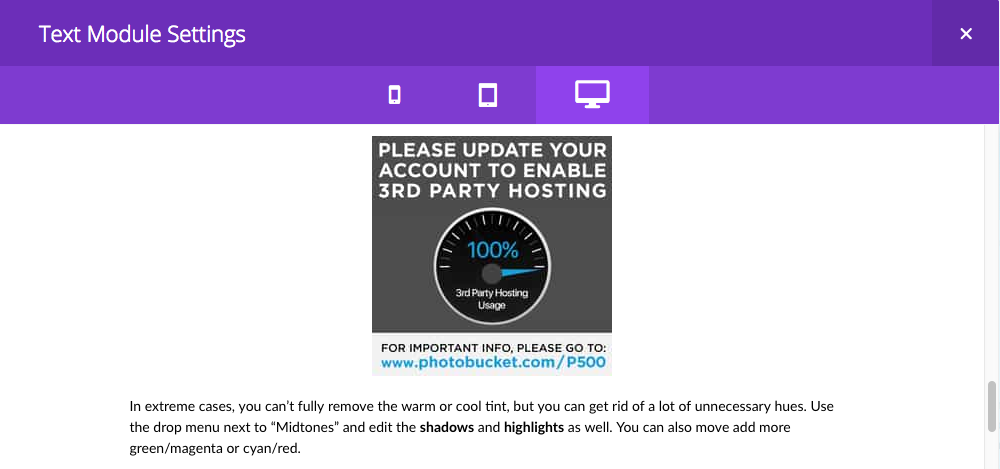
On Monday, I was cleaning blog posts (yes, you should be doing this too) when I saw something weird:

“What? This has to be a mistake,” I told myself going to check my account.
Photobucket decided to break links across the Internet. Unless you pay 399.99 a year to link to 3rd-party sites, you’ll have that pretty image forever.
What does this mean?
1) Template designer links were broken until you pay 399.99. Or you can move all your links over and update your templates instead of the work you had planned. Yay!
2) If you’re a blogger, you can either pay or have fun updating your posts going 11 years back. Sounds super, no?
Here’s my main pickle: I’m a businesswoman. I understand changing your structure to be more profitable.
I’m a businesswoman. I understand changing your structure to be more profitable. The way Photobucket went about this was more than wrong. It failed miserably not only in rollout but as a business. BBC has since picked up the story, along with Forbes and PC Mag: three industry news outlets you want on your side.
The entire situation is a huge mess and has left a lot of bloggers, forum admins, and online resellers in a huge bind. Instead of working on current projects, they’re on hold fixing the mess they created.
Under this entire situation, Photobucket did a lot of things wrong in the rollout, and they still continue to do so to this day.
Lack of communication.
There was no communication until this simple email appeared in inboxes AFTER the fact. A short blog post stated that there were going to be some changes but no detail about how major those changes were.
Photobucket played unfairly.
Not only was there no communication, but free customers also had to pay the highest tier to get their photos back. I’m not calling it ransom or blackmail, but others are and I don’t disagree. “$400 or else,” was the unwritten threat, which sounds like blackmail.
Their response has been terrible.
Probably because they know how wrong they are and don’t want to face the music. Again, my opinion, but take a look at their Twitter and Facebook. Photobucket gives the same generic answer to people’s questions. This isn’t the time for copy-and-paste answers. This is the time to fess up and be transparent.
Photobucket has yet to make the situation right.
There’s no explanation or transparency about why they pulled this move. Since 2003, hosting links to third-party sites has always been free of charge. After 13 years they work up and decided that was a bad idea. Why? What are you hiding, Shady McShaderson? You owe everyone an explanation. The longer you wait, the worse you look (it’s been a full week on this day of July 5, by the way!).
Now, enough ranting. I believe every situation is filled with lessons learned. For someone who believes in transparency and owning up to your mistakes, let’s look at four things to learn from Photobucket-gate.
Communication is key.
When it comes to your customers, you’re dealing with money. If you have to do a price change, explain why. “I’m raising prices to bring people on board and grow my team.” “This course is going up because more resources and one-on-one time will be provided.”
Explaining why gives consumers answers. While everyone may not be OK with it, they have a fair opportunity to make a decision with their money.
Respond to criticism, quickly and genuinely.
Right now, Photobucket is giving generic responses. It’s not going well with their customers, as you may guess. With a reputation for terrible customer service, this may be expected. However, this is the time for them to turn it around and do right.
Buffer took away their evergreen feature and customers were NOT happy. Buffer knew that. and responded to criticism personally responding to tweets and Facebook messages. They wrote an explanation of, lack of bandwidth in the office, and provided alternatives. Upsetting, but it’s an honest answer. And while it didn’t stop some people from leaving, it gave Buffer respect as a company.
Give your audience time to adjust.
Customers like good surprises. “Surprise you got 30% off of your purchase today!” Not “Surprise, we’re increasing your plan by 300% starting now!”
30 days is a good time for people to figure out what they want and need to do to adjust their business with this new change. It may not impact them too much, it may impact them a lot. Maybe they have questions before deciding what they want to do.
Make the situation right.
If you find you made a mistake in change, and we all do, own up to it. Apologize for the inconvenience and figure out how you’re going to make it better. Is it a discount? Is it credit? A new product? Refund? It depends on your situation, but owning up makes you look better in the long run than staying quiet.
Photobucket has a decision to make.
Start making the situation right and learn from being greedy, or see your company plummet to the end. The need for generating revenue is understood, but not being honest with your customer base will be the end of your business.
Big or small, you can learn what not to do. Setting values to put your audience first and running your business ethically will prevent you from the dangerous pitfalls of business and brand suicide.





